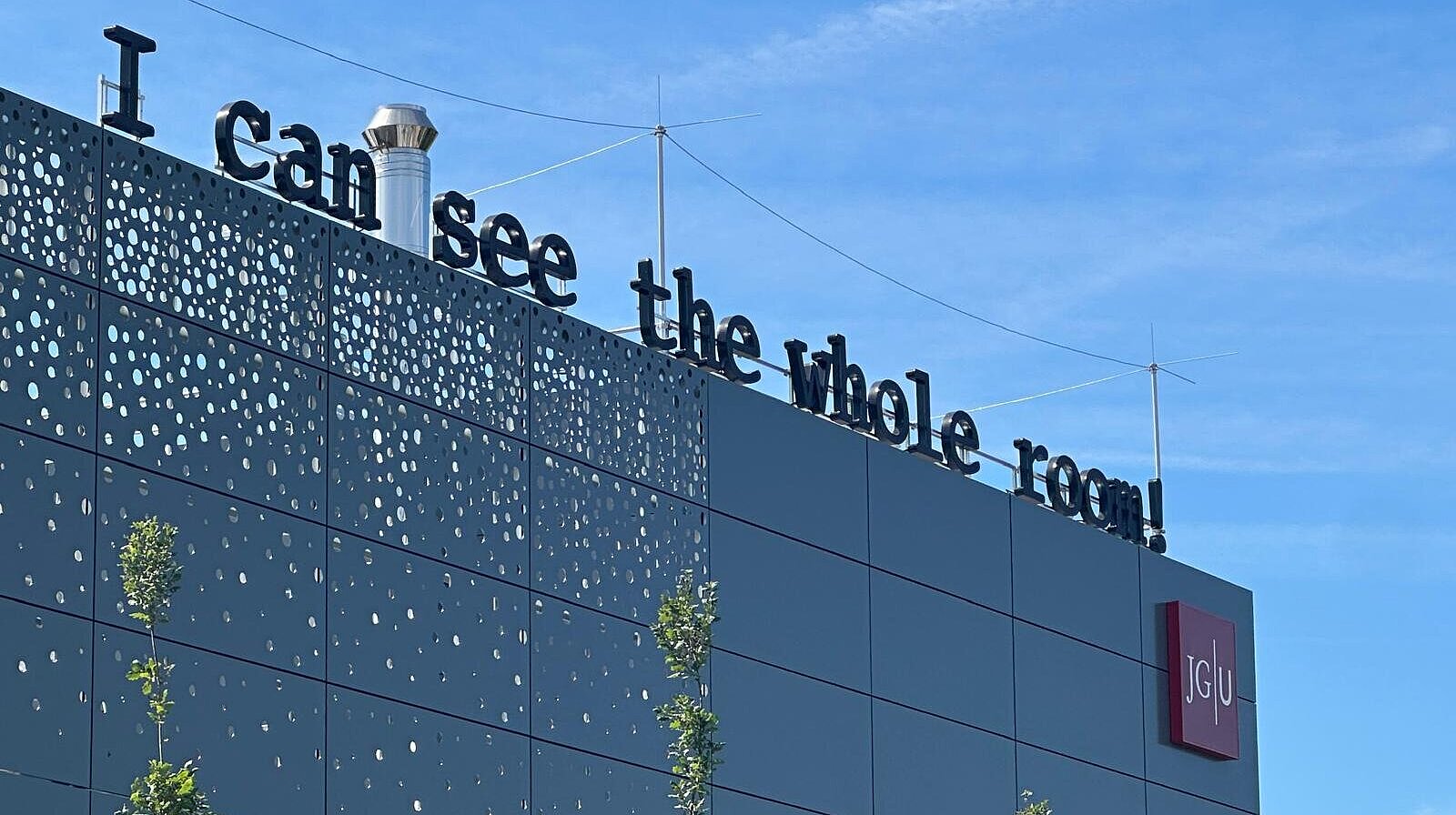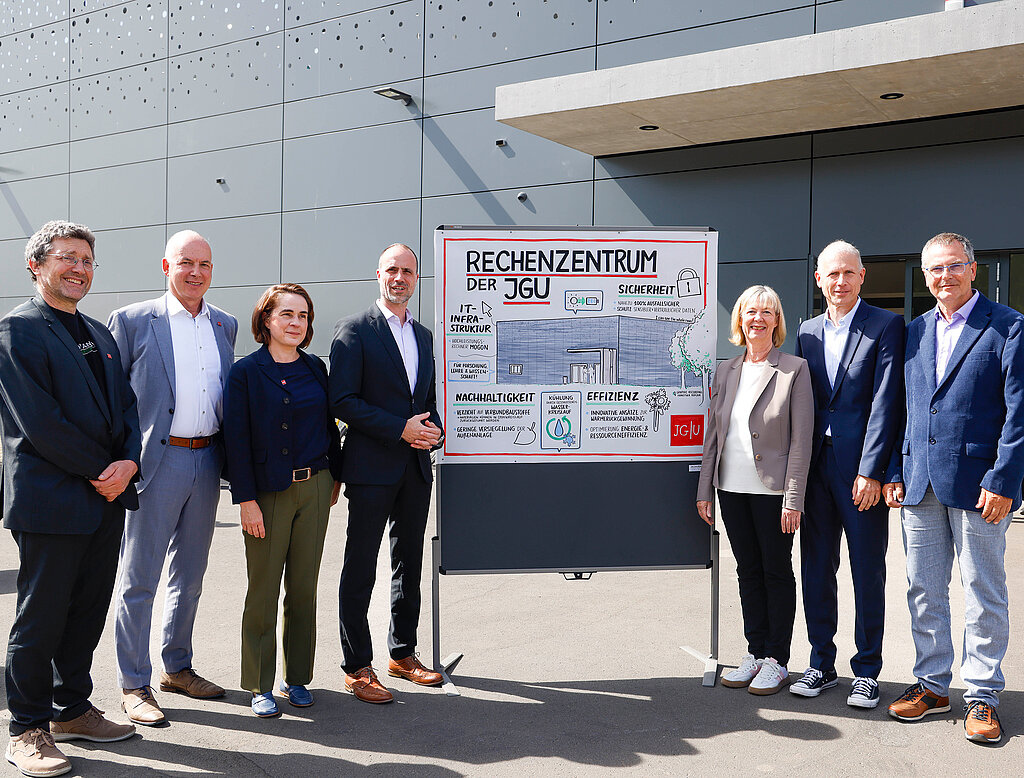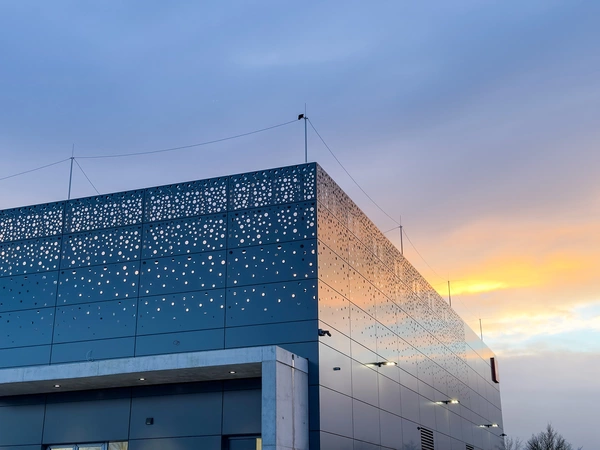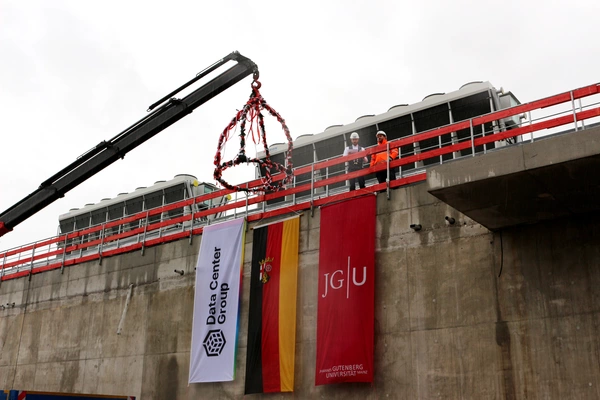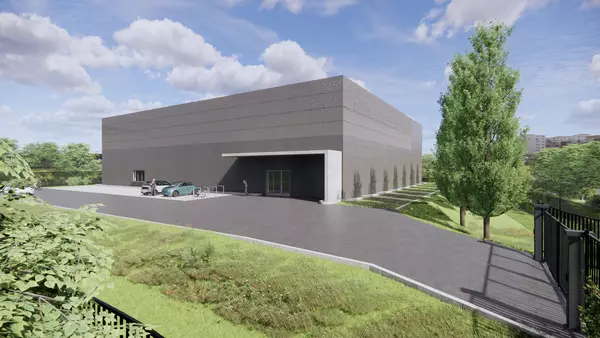Security, efficiency, and sustainability as central aspects of the data center’s design
Johannes Gutenberg University Mainz (JGU) has achieved an important goal: After two years of intensive construction, the new data center on campus is now operational. Minister of Finance and Construction Doris Ahnen, Minister of Science Clemens Hoch and JGU President Prof. Dr. Georg Krausch today opened the new building together with many guests from politics, IT and academia. The new building is of decisive importance, as the data center houses both the university IT infrastructure required for academic operations and administrative tasks, and the systems for National High Performance Computing (NHR). In order to optimally support top-level research and academic operations, JGU placed particular emphasis on security, availability and optimized system performance in the planning and implementation.
"The new data center is another important step in the continuous renewal process of university infrastructure – both here on the JGU campus and at other university locations in Rhineland-Palatinate. Modernization and expansion of Rhineland-Palatinate’s universities are among the most important tasks of our state. The data center sets technical, economic and ecological standards. Optimized energy and resource efficiency with highly efficient cooling systems, use of waste heat and photovoltaic installation stand for a highly functional and at the same time sustainable data center. Almost 31 million euros have been approved for the total construction costs – a good investment in Mainz as a research location," explained Doris Ahnen, Minister of Finance and Construction of Rhineland-Palatinate.
Science Minister Clemens Hoch also congratulated JGU on the opening of the new data center: "The new data center is not only an outstanding example of JGU’s technological performance and innovative strength, it is also a flagship for Rhineland-Palatinate as a research location. That this demanding construction project could be realized in a speedy and carefully planned process deserves great recognition. I wish the university much pleasure and success with this forward-looking building. It will further strengthen digitally supported research and teaching as well as high-performance computing and is also important for JGU’s supraregional visibility as an excellent site for research infrastructure."
Future-proof and sustainable IT infrastructure for teaching, science and research
The building combines two areas: In one area are the complete IT infrastructure of the university and the systems required for the Rhineland-Palatinate Science Network and the services offered as part of the Rhineland-Palatinate Data Center Alliance (RARP). In the other area are the high-performance computers MOGON NHR South-West and the planned successor system to MOGON II.
"The new data center sets standards for university and science," explained JGU President Prof. Dr. Georg Krausch. "For researchers from Mainz, Rhineland-Palatinate and also all of Germany, a modern and powerful IT infrastructure of top quality is indispensable – for example the Rhineland-Palatinate Science Network or also networked high-performance computing as a key technology for top-level research in many fields. In this way, the investment in the new data center of our Center for Data Processing contributes to ensuring that working groups that rely on powerful high-performance computers can maintain and further expand their leading position in their fields of research."
The data center is designed so that nearly 100 percent fail-safety can be ensured for IT operations and critical services such as email, learning management systems and databases are always available. Four predefined protection zones and a special access control system with sluice function protect sensitive and confidential data such as research results and personal data of students and staff.
In addition to security and efficiency, sustainability was a central aspect in the conception of the data center. JGU reduces its ecological footprint and equips the new building with various innovative, environmentally friendly technologies, for example
- through installation of photovoltaic modules on the free roof area;
- cooling of servers with a closed water cycle, mostly without the use of compressor refrigeration machines. The relocation of the HPC cluster MOGON NHR South-West to the new data center alone saves around 200,000 euros in electricity costs per year;
- innovative approaches to heat recovery, combined with the prospective use of waste heat for heating supply, thus optimizing energy and resource efficiency;
- avoidance of composite building materials, so that materials used can later be returned to the material cycle;
- low sealing of outdoor areas. In addition, all rainwater is retained and directed into ground basins, where it can evaporate or be reused.
For the construction of the new data center, JGU was assigned the building owner responsibilities by the state of Rhineland-Palatinate. "The new building was constructed by Johannes Gutenberg University Mainz in accordance with an agreement with the state enterprise LBB, with technical feedback from the construction department of the Ministry of Finance, under its own management," explained the Chancellor of JGU, Dr. Kerstin Burck. "The set goals of budget compliance, on-time completion and ensuring an optimal IT infrastructure were achieved through the procedure chosen by state and university."
The new data center is also a place of art. On the roof edge of the building shines the sentence "I can see the whole room! … and there’s nobody in it!" – an allusion to Roy Lichtenstein’s 1961 work, which thematizes the uncertainty of perception through technical devices. The sentence connects with the closed architecture and seems to question it. With the typeface "Courier," artist Thorsten Goldberg emphasizes the connection to the digital world of the data center.
Data and facts:
- Total area of the building: 1,870 square meters; about the size of ¼ of a football field
- Construction costs: 30.75 million euros
- PUE value: ≤ 1.15 – The key figure for the energy efficiency of data centers is the Power Usage Effectiveness (PUE). It determines how effectively the energy supplied in a data center is consumed. The aim during conception was to achieve the lowest possible value.
- 32 server racks in the enterprise area and 112 server racks in the HPC area (up to 84 in operation simultaneously)
- Maximum IT load: 3,600 kW
- Photovoltaic modules with an output of 73 kWp
- DIN EN 50600: current European standard for data centers and their infrastructure.
- The standard defines requirements for availability, reliability and security of data centers. This includes, among other things, requirements for planning, construction, operation and maintenance of data centers as well as requirements for building technology, infrastructure and IT systems in a data center. In addition, topics such as energy efficiency, environmental protection and sustainability in connection with the operation of data centers are taken into account.
- According to DIN EN 50600 there are four availability classes. Availability classes are categories that describe the degree of reliability and fail-safety of IT systems. The higher the availability class, the lower the risk of failure and the higher the security for the user.
- Data center areas: Enterprise (Availability Class 3) and High Performance Computing (Availability Class 2)
